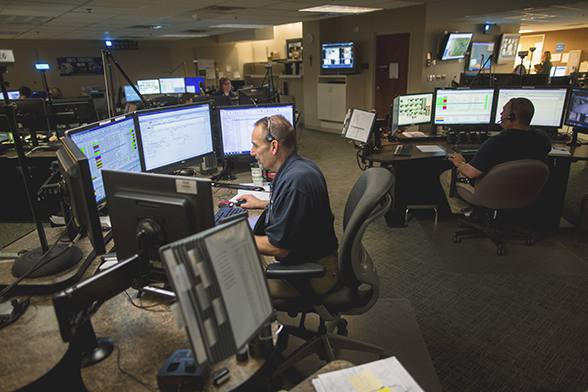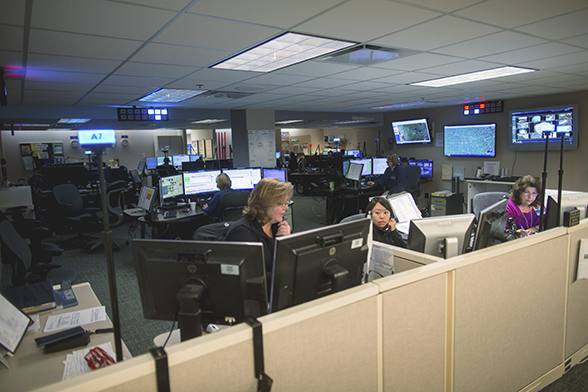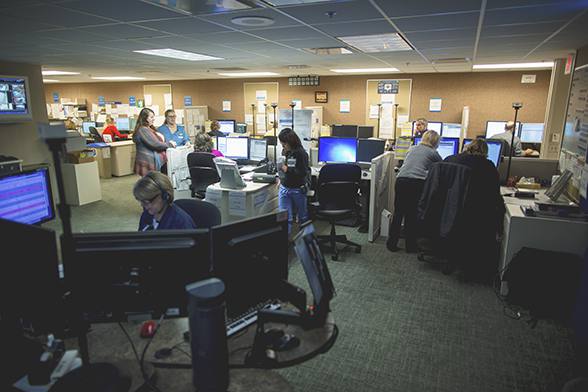Jan. 08, 2016
Some research has shown that as many as one-third of patients transferred to Level I regional trauma centers could have been safely treated by the referring hospitals. Other studies have found the opposite — that transfer of seriously injured patients, especially to pediatric trauma centers, is often delayed, resulting in increased morbidity and death.
The Admission and Transfer Center (ATC) and Emergency Communications Center (ECC) at Mayo Clinic's campus in Rochester, Minnesota, aim to prevent both. The centers exist to rapidly assess, triage and transport injured patients to definitive care while also helping local facilities determine which patients can be cared for closer to home.
ATC supervisor Darla R. Meurer, R.N., M.S.N., says the center is staffed by a multidisciplinary team, including nurses with extensive emergency department (ED) experience. A core group of nurses works exclusively in the ATC and 24 others rotate between the ATC and ED. That level of experience, combined with knowledge of the Mayo system, is crucial for helping coordinate emergency care.
"Our nurses are the touchpoint for all the specialties on the Rochester campus," Meurer says.
When you call
 ATC supervisor Darla R. Meurer, M.S.N., R.N.
ATC supervisor Darla R. Meurer, M.S.N., R.N.
Admission and Transfer Center (ATC) supervisor Darla R. Meurer, M.S.N., R.N., discusses a case with the nursing team.
When an ATC nurse receives a call from a referring facility, the first step is to gather essential clinical information as well as demographic data to help identify the patient within the Mayo system. For patients needing transfer, electronic algorithms are used to help determine the best specialty service for admission and the appropriate level of care.
The algorithms — evidence-based medical decision trees for specific conditions, such as trauma, STEMI or stroke — were originally developed in 2009 and recently updated to make them more intuitive, functional and service oriented. A surgeon or other specialist also may participate in the decision-making process.
Meurer explains: "If we receive a call from a referring provider about a patient with an abdominal aortic aneurysm, for instance, we will ask for images and get a vascular surgeon on the line. Based on the images and physician decision, we can help arrange for the patient to go directly from the helipad to the operating room.
"Some patients, especially trauma patients, should first be evaluated in the ED. ATC nurses can rapidly accept them into the ED at Mayo Clinic Hospital, Saint Marys Campus, as well as notify the ECC for transport. We can also bring other specialists into the conversation to help the referring provider and ensure we're making the best decision for each patient."
Emergent cases are handled within minutes, and assessment, triage and transport dispatch occur almost simultaneously.
 ECC workstations
ECC workstations
Mayo's Emergency Communications Center (ECC) features multiple workstations to cover a large service area.
 ATC nurses work closely with the ECC
ATC nurses work closely with the ECC
Admission and Transfer Center (ATC) nurses work in close proximity to the Emergency Communications Center (ECC) staff.
 Team at work
Team at work
The Admission and Transfer Center (ATC) and Emergency Communications Center (ECC) team at work.
"We are located next to the Emergency Communications Center," Meurer explains. "The ATC nurses have a light system to quickly notify the ECC when they have an emergent case needing transport. The ECC will then confirm the patient's location, do a weather check and determine what transport is available. That kind of coordination is essential for ensuring that patients receive appropriate, timely care."
Social workers are available to help with hospital-to-hospital transfers. At admission, they consult with the referring nurse or case manager to look for any barriers to discharge and help provide families with information and support.
Meurer says the ATC, which is open round-the-clock, handles around 100 patient cases from referring providers on weekdays and 60 to 70 patient cases on weekends. Most are transfers, but about 15 to 20 percent are consultations.
"Our specialists can help smaller facilities determine whether they can manage a particular patient," Meurer says. "Sometimes a transfer request results in a consult because many providers now want to care for patients locally, and we are happy to help with that. We have a great appreciation for providers in smaller hospitals with limited resources, and we try to expedite transport for them as well as provide immediate access to our consulting physicians."